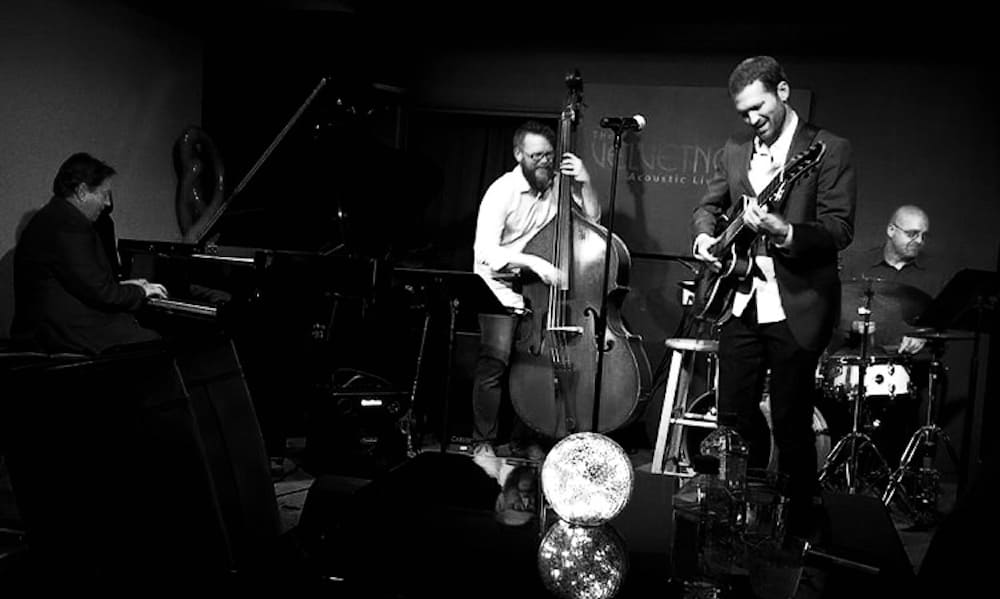Artist Features
Why I Switched to a 7-String Guitar

From the time I started playing in 1996, 7-string guitars had been seldom (if ever) on my radar.
In 2004, I went to a Benedetto Players concert in Savannah. I got to meet and hear Bucky Pizzarelli, Frank Vignola, Jimmy Bruno, Howard Alden and Martin Taylor. To say I was inspired would be the understatement of the century. While they were all incredible in their own unique approaches, it was Howard Alden who stood out to me the most. The way he took advantage of the extra low range was something I’d never heard before.
Over the following years, I began getting more and more calls for solo and duo gigs. I’d had some great teachers, and the idea of making the guitar a one-man rhythm section was always appealing to me. I was regularly accompanying vocalists and horn players, and occasionally playing duos with drummers.
In 2009, I took a huge leap of faith.
The most expensive one I’d ever made. I had developed a relationship with Jerry Sims of Sims Music in Columbia, SC and tried out a few of his guitars in the shop. One of them was a Benedetto Bravo 7. I immediately fell in love.
Upon completion of the guitar in 2010, I made it my primary instrument. While the idea of adding a new string was intimidating, the learning curve wasn’t nearly as steep as I’d thought. Using the George Van Eps tuning (all standard plus a low A) made the transition much easier. Having been influenced tremendously by Joe Pass, I was already familiar with the chords/walking bass line technique he pioneered, but now I had over a half an octave added to the lower range! Knowing how chords were built on the “normal” A string and applying it to the low A not only created richer sounds; it also allowed for more interesting voicings that I couldn’t do with a 6-string guitar.
My fellow musicians noticed the difference immediately. Especially the bass players…but I won’t go too far into that. I still want them to be my friends.
At this point, playing a 7-string is the most comfortable situation for me.
Every time I switch back to a 6-string it seems even more challenging than the first transition! I would challenge ANY guitar player out there to spend a couple weeks with a 7-string and not want to make the change. And I mean any guitar player, in any genre. The rockers tend to tune the low string to a B, which is more logical, but I’m the most comfortable with the Van Eps tuning.
There aren’t many of us, but we’re definitely out there. George Van Eps introduced the instrument to the jazz world decades ago, so we all owe him a great deal. Bucky and John Pizzarelli, Howard Alden, Craig Wagner, Steve Herberman, Ron Eschete, Ted Ludwig, Steve Masakowski, Howard Paul, Chip Henderson, and Gerry Beaudoin are all currently putting their own stamp on the 7-string market. For something a bit more unorthodox, and someone who’s been arguably my biggest influence, check out Charlie Hunter.
While the extended range makes a tremendous difference in playing solo or accompanying singers, it still sits well in all settings. If a bass player is on the gig, just stay out of their register while they’re playing! It also works surprisingly well in an organ trio setting if you want to give the organ player a break.
Most of my gigs these days are solo, and I’m always learning new tunes, which allows me to discover all sorts of new ways to approach the guitar. I think it’s safe to say I’m a 7-stringer for life.
-

 Jazz Guitar Lessons2 weeks ago
Jazz Guitar Lessons2 weeks agoNew JGT Guitar Lesson: Analyzing “Without A Song”
-

 Jazz Guitar Lessons4 weeks ago
Jazz Guitar Lessons4 weeks agoNew JGT Guitar Lesson: Considering “Falling Grace”
-
Artist Features1 week ago
New Kurt Rosenwinkel JGT Video Podcast – July 2024
-
Artist Features2 weeks ago
JGT Talks To Seattle’s Michael Eskenazi

















